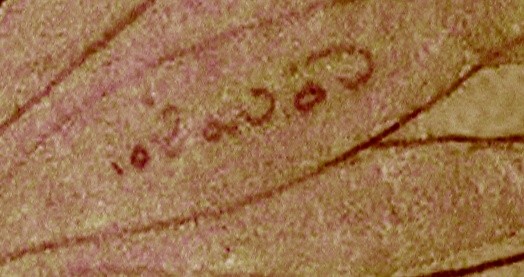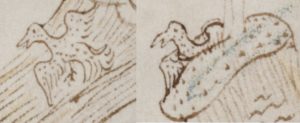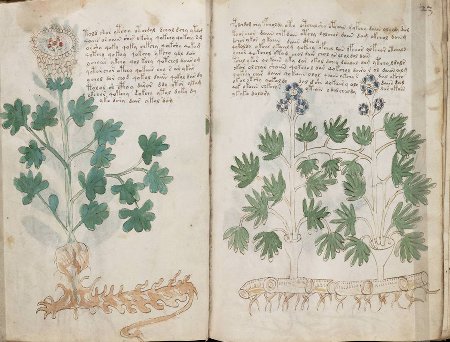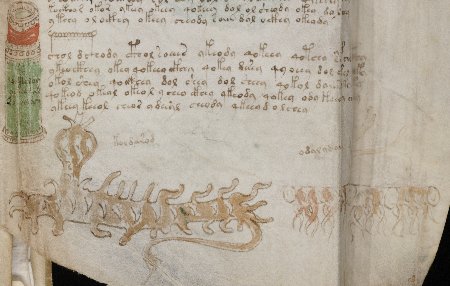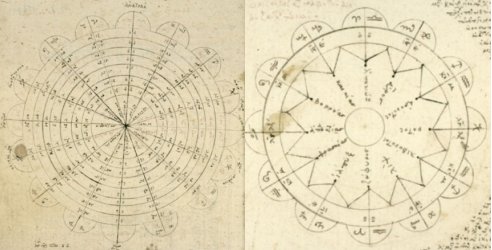For years, numerous Voynich researchers have pored over the VMs’ confusing images, hunting for any tiny clues that might possibly be hidden beneath the clumsily-applied paint. And yes, I admit that I’ve done probably more than my fair share of this kind of thing (Curse pp.96-102 stands as testament to this endeavour): so it’s now interesting to hear that René Zandbergen believes that there is “rather strong” evidence (a) that some of the plant parts in the VMs have letters to direct the colouring of that page (let’s follow Vera Segre Rutz and call them “colour annotations“), and (b) that those colour annotations are written in German. Here’s what René says:-
If we go back to the [alchemical herbal] web page of Philip Neal, one of the herbals mentioned there is “Vicenza, Biblioteca Bertoliana MS G.23.2.3 (362) s. 15, Italy and Germany“.
Actually, “G.23.2.3” is the old shelf mark and now it is usually referred to as “Vicenza MS 362“. It’s a 15th century Italian herbal, with illustrations from the alchemical herbal tradition. It also says ‘Germany’ because Segre Rutz in her book quoted by Philip describes that it has ‘colour annotations’ in German. Indeed, in the few illustrations I have from this herbal, you can easily see many occurrences of ‘rot’, ‘gr(ue)n’, ‘gelb’ (red, green, blue) and also ‘erd’ (earth) or ‘weiss’. Additionally it has one illustration with alternating red and green leaves, with alternating single ‘r’ and ‘g’ characters written inside.
These all look extremely similar to the few colour markings in the early quires of the Voynich MS. There’s a clear ‘rot’ in the root of f9v (already seen by many), there’s the ‘g’ in f1v, and then there’s another ‘rot’ with some individual ‘r’s under the paint of the viola tricolor mentioned above, and another ‘g’ to the side of the flower on the right.
Here’s one page of Vicenza MS 362 with ‘rot’ in the root (barely visible in this resolution), while this page has alternating ‘r’ and ‘g’ characters (and the same problem).
Well… the first thing to note is that if Vicenza MS 362 is an Italian herbal with German colour hints, then the same could well be true of the Voynich Manuscript – if we’re talking about a manuscript with depictions of Italian castles (there are actually two sets of swallowtail merlons on the nine rosette page), a provenance that (currently) starts in Prague, and Stolfi’s putative “heavy painter” adding organic-looking paints later in the VMs’ life, then there’s no obvious conflict between the two narratives. All of which begs a whole constellation of questions, such as:-
- Can the letters hidden in the Voynich’s plants be proven to be colour annotations?
- Can the letters hidden in the Voynich’s plants be proven to be written in German?
- Can the letters hidden in the Voynich’s plants be proven to have been written by the author?
- Can the letters hidden in the Voynich’s plants be proven not to have been written by the author?
- Can the letters hidden in the Voynich’s plants be dated independently of the VMs itself?
- Can the letters hidden in the Voynich’s plants be proven to have been written by the author of one of the marginalia?
You already know what I’m going to say: let’s look at the primary evidence for ourselves. With the help of Jon Grove’s clever colour remover plugin (which I recently discovered can work inside IrfanView, a highly recommended hack!), you can make a pretty good stab at seeing past the paint to the letters beneath. Here is an image of what I found when I tried this on the top left flower on f9v (the viola tricolor page I mentioned recently):-
Note that even though I tried really quite hard to image process this to a satisfactory state, I didn’t really succeed to the degree that I’d hoped: but still, I think it’s good enough to see that (a) the claim that the top left petal clearly says “rot” doesn’t really hold up; (b) that there are colour annotations in at least three of the five petals in the same hand; and (c) that the colour annotations are even smaller than the Voynichese text.
Let’s move on to the claimed colour annotation in f4r’s root. In “The Curse”, I built a whole cryptogrammatic superstructure on top of my reading of this (rotated) as “TOA”, which is one possibility (though in retrospect, I do see how it seems a little hopeful). However, I also think that reading “rot” here (as a column of letters) is just as hopeful but in a completely different way.
However, if you assemble these two (claimed) colour annotations onto the same page and add in the f66r and the f116v marginalia, I think you find something really very surprising indeed:-
What I’m claiming is that they all seem to share the same unusual-looking “topless p with a preceding upstroke” first letter (even the supposed “portas” word, which I’ve never believed was the right reading at all). What does it mean? Was all this added by the author or by a later owner?
Update: here’s the leaf Voynichese painted over in f2r René mentions in his comment #1 below (but with the green paint removed), with the rather puzzling EVA “ios.an.on“:-



